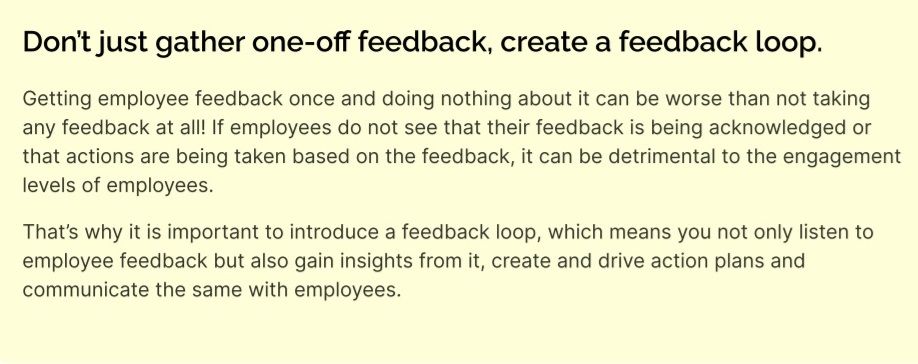Listening to employee feedback (especially) in the midst of a crisis

Why listen to your employees during a crisis?
Crises are a time of great uncertainty and unforeseen challenges. As a people leader, one of your top priorities during these times must be to ensure your employees feel safe and supported. And how can you do that?
By continuously listening to your employees’ concerns and needs.
Only when you can uncover the kind of help and support that employees are expecting from you can you actually get down to delivering it.
With your plates already full during a crisis, you might feel like you don’t have all the time to listen, analyze and then act on employee anonymous feedback. Yet, the truth is also that you can’t simply ignore the importance and relevance of listening to your employees.
How then do you weave in listening to your already packed schedules? Let's find out.

But before we get to the ways in which you can collect and act on feedback, let’s quickly reiterate the importance of listening to employees during a crisis situation:
- Establishes trust & care: Employees want to know that their organizations care for them. And by introducing a feedback loop with employees, you are allowing your workforce to share their thoughts, concerns and opinions, while also making them feel valued and heard.
- Uncovers the needs and emotions of employees in the here and now: Things are in a constant flux during a crisis and the needs and emotions of your people are also constantly changing. Therefore, to be able to continuously listen to them and meet their needs is of utmost importance at the moment.
- Managers are better equipped to provide individualized support: Even though everyone is in the same storm, people are in different boats. This means that everyone is looking for answers and solutions particular to their situation. And the best person to be able to provide that level of individualized support is a manager. Building a feedback loop will enable managers to be on top of their employees’ needs.
How can you listen to your employees during a crisis?

In all honesty, not listening to your employees isn’t a choice during a crisis. Also, with the diversity of challenges people face during a crisis, it is nearly impossible to assume that your entire population is going through the same challenges by listening to a select few.
So, here are two suggestions we recommend that will enable you to listen to all your employees and then drive action.
Introduce pulse surveys.
Are you re-reading what we just said? Because running a survey during a crisis can seem too much to ask of you but there is nothing that can be a more efficient and faster way to gauge your employee moods and needs than a survey.
Pulse surveys are quick, short surveys on a certain issue that can be sent to employees at fixed intervals to capture their continuous feedback. These surveys that are more lightweight than your annual engagement survey can help you quickly collect employee feedback and act on it right away.
Real-time insights. Real-time response.
Or, support managers to run one-on-one meetings.
Crises are also a time when employees need individualized support. With everyone going through challenges that are unique to themselves, managers can uncover the needs of individual team members and be able to provide solutions or act on queries relevantly. However, running effective one-on-one meetings during a crisis also requires managers to be prepared for tough conversations and go beyond the more light-hearted or work-oriented conversations.
Let's learn in detail about both, pulse surveys and one-on-one meetings.
How to run simple and quick pulse surveys?
Pulse surveys are like check-ins - 5-6 questions long, not time consuming and very easy to answer. These are usually sent out at regular intervals to employees enabling you to stay on top of progress in areas such as employee satisfaction, employee engagement, employee wellbeing and more.
At the time of a crisis, pulse surveys can be your best bet to proactively listen to your employees. And here are steps that will help you build and drive quick pulse surveys.
- What’s your intention? First and foremost, decide your objective. What is it that you want to know from your employees. Do you want to know about their physical and mental wellbeing? Or, do you want to understand what employees think about how the organization is managing the crisis? Be clear about your intention.
- Prepare the questions: While it may be tempting to pull out a questionnaire from the internet, check if it goes with your organization. If not, edit it to go with your organization’s culture or simply, craft a new one. Ask the right employee survey questions around what you want to really measure and areas that are most impacted right now, like employee productivity or wellbeing.
- Identify distribution: Make an informed decision around how you want to administer the survey. With employees working remotely, it makes sense to also send these survey links via Whatsapp, SMS and other mediums.
- Communicate your intent to employees: But even before the survey reaches employees, communicate your intent to them. What is the purpose of the survey and what you plan to do with employee feedback. Regular communication will build trust and increase participation.
- Follow up on the results: Share the results and action plan after the survey. Employees will feel like their feedback is valued when you make it a point to communicate with them the results as well as your course of action on the feedback.
A few quick reminders when running a pulse survey:
- Structure questions on issues that are most likely undergoing fluctuation right now. Employee wellbeing or crisis management, for instance.
- Run surveys as long as you are sure you can act on the feedback. An incomplete feedback loop can be more detrimental than not running a survey itself in the first place.
- Use pulse surveys to continuously listen to employees and act on the feedback.
Want help with running automated pulse surveys to your employees?
Try CultureMonkey.
Leaders, hold effective one-on-one conversations.

Let’s start by busting a few myths about one-on-one meetings.
- The manager NEED NOT have answers to all questions: At a time of a crisis, it is very likely that employees have queries and concerns that a manager may not have immediate answers or solutions to. And that is okay. Managers do not need to have solutions for everything. And even if they do not have information to a question being asked to them, accepting the same will not do any harm. What people primarily need at the moment is to be able to voice their concerns and be heard.
- Managers DON’T need to set unrealistic expectations: No, hard conversations do not need to be without boundaries. Setting unrealistic expectations for employees and not being able to meet them can be more harmful than telling them that certain things may not be possible at the moment. Your employees definitely know that everything they ask for can’t necessarily be met. Yet, the idea is to give them a space where they are able to comfortably communicate their needs without fear.
Tips to run one-on-one meetings.
A manager-employee relationship can be critical for teams to tide through tough times. As an HR manager, here are a few tips you can share with your managers to drive effective one-on-ones.
- A conversation beyond work deliverables: Of course, there could still be timelines to be met and projects to be completed. But with so much anxiety and fear surrounding a crisis situation, a lot of employees may not be at their physical, mental or productive best. That’s why shifting the focus of conversations to how employees are doing, how their families are doing, and how they are coping is very crucial.
- Bring intentionality: Yes, these conversations may not be as structured as other work meetings, yet, it needs to have an agenda and clear focus. Know what needs to be asked to employees - present the questions and get feedback. See this as an opportunity to build trust between the manager and the team.
- Welcome emotions: These conversations are going to be personal. And with times being tough, managers must make space for employees to remove their professional masks and embrace emotions. Encourage your team leads to have a human-to-human conversation over a manager-to employee one.
- Individualized support: Everyone is different. Managers should tailor their discussions around each individual, trying to really understand who they are, what keeps them going, and what some of their concerns may be.
- Embrace honesty: No one is expected to have it all together right now. And managers being able to demonstrate vulnerability to employees will encourage them to do the same. Equip managers to share information that they have and not be afraid to say no when they don’t have certain answers.
- In the here and now: Communicate to managers to be present during the one-on-ones. Attending calls or answering emails are straight up disrespectful to employees. The best is to mute notifications, turn off the phone and listen intently.
- Listen more, talk less: Prep managers to listen intently and ask questions. Show genuine interest in what employees are sharing. Be considerate about the feedback that is given.
- No substitute for clarity: Clarity is kind. Even when conversations get uncomfortable, communicate clearly. Have a basic plan around what these conversations are going to be like and have some messages clearly planned out that you wish to communicate.
Conclusion
Use pulse surveys.
Train your managers to run effective one-on-one meetings.
Or, just look through your resources to find out ways in which you can best listen to your employees.
The need of the hour during any crisis is that you are able to give your employees what they are seeking and not just what you think they need, for which listening to employee feedback becomes critical.
Want to discuss best ways to listen to your employee feedback during a crisis?
Feel free to reach out to us.



